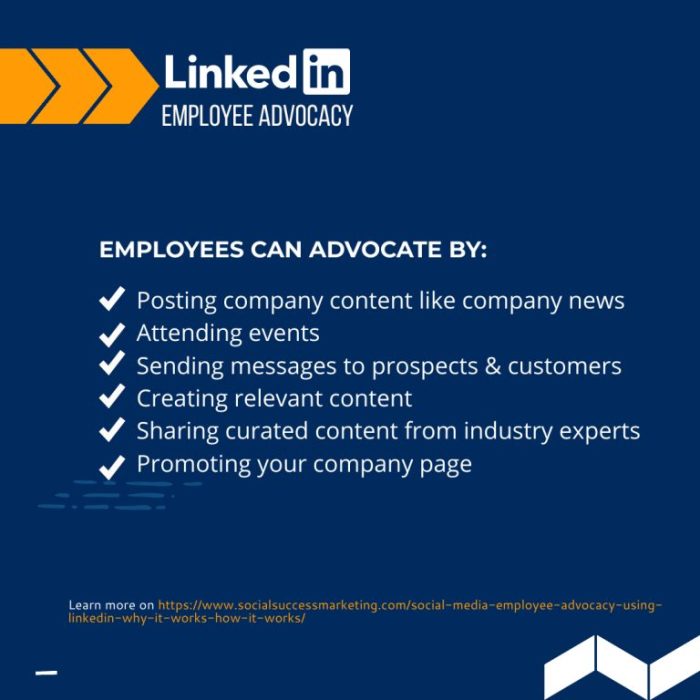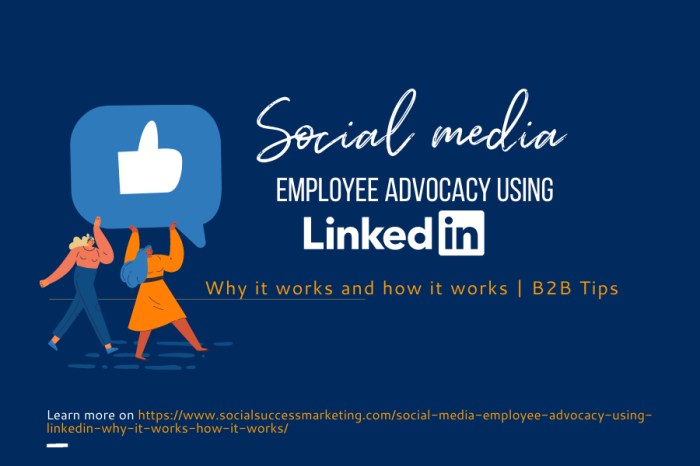Using LinkedIn for Employee Advocacy takes center stage, offering businesses a powerful tool to amplify their brand through their own employees. This platform provides a unique opportunity to showcase internal talent and expertise, ultimately fostering trust and authenticity in the eyes of the audience. Let’s dive into how businesses can harness the potential of LinkedIn for employee advocacy.
Introduction to Employee Advocacy on LinkedIn

Employee advocacy on LinkedIn refers to the practice of employees sharing and promoting their company’s content, products, and services on their personal LinkedIn profiles. This can help increase brand visibility, credibility, and engagement on the platform.
Importance of Employee Advocacy for Businesses on LinkedIn
Employee advocacy is crucial for businesses on LinkedIn as it can help amplify their reach, establish thought leadership, and build trust with their target audience. When employees share company updates, industry insights, and success stories, it humanizes the brand and increases authenticity.
- Increased Reach: Employee advocacy can significantly expand the reach of a company’s content on LinkedIn, reaching a larger and more diverse audience.
- Enhanced Credibility: When employees share about their work experiences and expertise, it lends credibility to the company and its offerings.
- Improved Engagement: Employee advocacy can lead to higher engagement rates on LinkedIn posts, as people tend to trust recommendations from individuals they know.
Examples of Successful Employee Advocacy Campaigns on LinkedIn
Microsoft’s Employee Advocacy Program: Microsoft encourages its employees to share company updates, product launches, and industry news on LinkedIn. This has helped the company reach a wider audience and establish itself as a thought leader in the tech industry.
IBM’s #NewCollar Campaign: IBM launched the #NewCollar campaign, encouraging employees to share stories of skills development and career growth on LinkedIn. This not only showcased the company’s commitment to employee development but also attracted top talent to the organization.
Setting Up an Employee Advocacy Program on LinkedIn

To create a successful employee advocacy program on LinkedIn, it is important to follow a strategic approach that involves identifying, recruiting, and training employee advocates effectively.
Identifying and Recruiting Employee Advocates
- Start by identifying employees who are already active on LinkedIn and have a strong presence on the platform.
- Look for employees who are passionate about the company and its values, as they are more likely to become enthusiastic advocates.
- Consider employees from different departments and levels within the organization to ensure a diverse group of advocates.
- Reach out to potential advocates individually and explain the benefits of participating in the program to spark their interest.
Training Employees to Become Effective Advocates
- Provide training sessions to educate employees on the best practices of using LinkedIn for advocacy purposes.
- Teach employees how to create engaging and relevant content that aligns with the company’s messaging and goals.
- Encourage employees to share company updates, industry news, and their own insights to showcase their expertise and boost engagement.
- Set clear guidelines on how often employees should post, what type of content is appropriate, and how to interact with their network effectively.
Leveraging LinkedIn Features for Employee Advocacy: Using LinkedIn For Employee Advocacy
LinkedIn offers a variety of features that can be effectively utilized for employee advocacy efforts. From posts and articles to stories, employees can leverage these tools to showcase their expertise and promote their organization.
Using LinkedIn Posts for Employee Advocacy, Using LinkedIn for Employee Advocacy
- Create engaging and relevant posts that highlight industry trends, company achievements, or personal insights to attract a wider audience.
- Encourage employees to share company updates and news on their profiles to increase visibility and reach among their connections.
- Include relevant hashtags and tag the company page in posts to improve discoverability and engagement.
Optimizing Employee Profiles for Advocacy Efforts
- Ensure that employee profiles are complete with a professional profile picture, compelling headline, and detailed work experience to establish credibility.
- Encourage employees to showcase their skills and expertise by regularly updating their profiles with relevant content, certifications, and achievements.
- Add a personalized touch to profiles by including a summary section that highlights individual strengths and contributions within the organization.
Utilizing LinkedIn Analytics for Advocacy Campaigns
- Monitor the performance of advocacy campaigns by tracking metrics such as post engagement, profile views, and follower growth using LinkedIn analytics.
- Identify top-performing posts and content types to understand what resonates with the audience and tailor future advocacy efforts accordingly.
- Utilize demographic and engagement data to target specific audience segments and optimize content strategy for maximum impact.
Creating Engaging Content for Employee Advocacy on LinkedIn
Developing compelling content for employee advocacy on LinkedIn is crucial to grabbing the attention of the target audience and driving engagement. By understanding what resonates with your audience, you can create content that encourages employees to share and amplify your message on the platform.
Types of Content for Employee Advocacy
- Text: Thought leadership articles, industry insights, and company updates in a concise and engaging manner.
- Images: Infographics, quotes, and visually appealing graphics that are easy to consume and share.
- Videos: Company culture videos, product demos, and behind-the-scenes footage to bring a personal touch to your content.
Maintaining a Consistent Content Schedule
- Plan ahead: Create a content calendar to map out what content will be shared and when, ensuring a steady flow of posts.
- Encourage employee participation: Involve employees in the content creation process to keep them engaged and motivated to share regularly.
- Monitor performance: Track the engagement metrics of your content to understand what resonates with your audience and adjust your content strategy accordingly.





